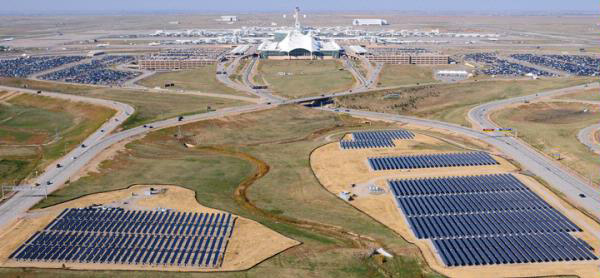Rooftop Solar on Municipal Buildings Could Save Cities Millions

We talk often about California, Arizona, and Hawaii as solar leaders, but Colorado is a state that knows clean energy. It ranks sixth for solar, and has plenty of potential to become an even bigger solar hotspot. But what about its unused city space? A report from the Institute of Local Self-Reliance cited that the roofs of municipal buildings could generate thousands of megawatts (MW) of solar power for cities, saving them millions of dollars.
A Tale of Two Solar Powered Cities
Cities already involved in municipal solar have already proven they’re saving money. The Denver Post reports that in New Bedford, Massachusetts, they’ve installed 16 MW of solar, and are saving between $6 to $7 million per year on their electricity bills. Over in Lancaster, California, they’re saving $450,000 by doing the same thing. And the 50 largest U.S. cities — particularly Los Angeles, Phoenix, and San Diego — account for 6.5 percent of all solar photovoltaic capacity.
In this latest study, the Institute estimates there are enough municipal sites to hold 5,000 MW of rooftop solar panels. According to the Institute’s director of democratic energy John Farrell, solar is really a good deal for cities. However, cities cannot get the largest solar incentives, because “cities don’t pay federal taxes.” The 30 percent federal tax credit that currently exists is unavailable to them.
Denver’s Solar Potential
In Denver, there’s around 14 MW of solar installed, with the largest installations at Denver International Airport (10 MW are installed in four arrays — over 42,000 solar panels). But without the financial incentive to offset the costs of building rooftop solar for municipal buildings, it doesn’t make any sense for Denver to build its own arrays.
Right now, Denver, along with other major cities, get solar energy through purchase power agreements. Actually, nearly half of U.S. states allow for purchase power agreements or leasing, meaning you can buy solar from a third party. But if they could afford to install solar themselves, it looks like a city as large as Denver could save its residents a ton of money .
Yet there’s still plenty blocking the city from embracing solar. While many cities can get lower interest rates, it still takes a lot for them to get a developer to get financing. “There may be some buildings that will need a new roof or historic buildings, but mainly it is a question of political will and wrapping their heads around the idea of buying energy someone besides the utility company,” said Farrell. “It is just another procurement exercise.”
What do you think of cities using solar to defray electricity costs? What’s the best solution? Tell us in the comments!
Image Credit: Urban Land Conservancy under a Creative Commons license
